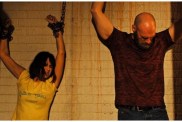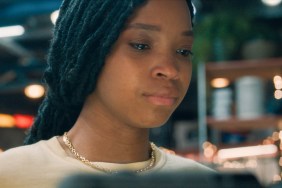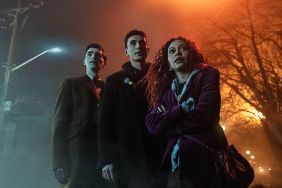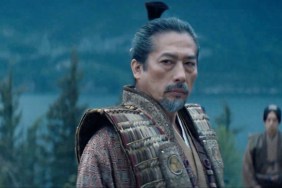Paul Crowder received a lot of recognition for his amazing editing work on Stacy Peralta’s skateboarding doc Dogtown and Z-Boys, something that he carried over into his first documentary as a director, last year’s Once in a Lifetime: The Extraordinary Story of the New York Cosmos (if you click on the title, you’ll see that it was one of this writer’s favorite movies of 2006).
Crowder’s latest movie is even more ambitious, taking a comprehensive look at the career of England’s most notorious rock band of the ’60s and ’70s in Amazing Journey: The Story of the Who, a movie co-directed with legendary rock archivist Murray Lerner. It follows the band from their early days as a cover band through the worldwide success of their rock opera “Tommy” to the death of drummer Keith Moon, which led to a dry spell and an eventual dissolution before reforming in the mid-90s to do a couple of tours before bassist John Entwhistle died just as suddenly and tragically. “Amazing Journey” features surprisingly candid new interviews with Roger Daltrey and Pete Townsend talking about many subjects that were never addressed in Jeff Stein’s earlier doc The Kids Are Alright as well as amazing never-before-seen footage of the band throughout their years.
Crowder once again found a way to pull a lot of footage and interviews together into a tight two-hour package that can be seen on VH-1 without commercial interruptions this Saturday before being released next Tuesday in a DVD package that includes a second disc called “Six Quick Ones” which gets more in depth into what each member of the band brought to the mix and includes rare early footage of the band performing at the Railway Hotel as the High Numbers before their first single as The Who. Together, they’re an amazing package for any fan of the band or of rock music in general who may be curious how this four-piece band has lasted for over forty plus years despite so many hardships.
After talking to Crowder last year, ComingSoon.net had a chance to talk with him about the band, the movie, and he also shared a bit about his background and a couple of secrets about the unique visual style that makes his documentaries so dynamic.
ComingSoon.net: I’m so glad I had a chance to see this in a theatre before the DVD release, because it plays really well on the big screen.
Paul Crowder: It plays great in a theatre actually, and it’s a shame you missed Toronto ’cause when we played at the Elgin, the sound was brilliant, and it really sells the film a lot more, it’s like a rock concert almost.
CS: How did you first get involved with this? It must have been a lot of work getting everything together, so were you doing this at the same as “Once in a Lifetime”?
Crowder: No, basically I got brought in just about May 2006, I got involved with the project. I believe Murray Lerner had been involved with it for a while, compiling media and researching and compiling a bunch of the interviews, probably about 60-70% of the interviews.
CS: That must have been right after then, because that’s about when “Once in a Lifetime” premiered at the Tribeca Film Festival.
Crowder: Yes, that’s right. In fact, I just got back from that, and I was doing other bits and pieces, and I remember getting the Email and just jumping out of my chair with delight. “Woah, you’re kidding me. The Who? Right, how much do I have to pay to do this?”
CS: I guess that answered my question whether you were a big Who fan or just found them to be an interesting subject matter.
Crowder: No, I was a big Who fan, Keith especially. I remember back in my way early days of editing, when I was doing “Behind the Music”, I did the Ozzy Osbourne one , and they were doing the Keith Moon one in the edit bay next to me, and I tried to trade with the guy. “Dude, you do Ozzy and I’ll do Keith.” I couldn’t. I had to do Ozzy. So when I got this, I was really excited.
CS: I didn’t realize that you have a background editing for VH-1. That makes a lot of sense that you have that music background already.
Crowder: Yeah, I mean, it was me and about four or five other editors that were the thrust of the production, editing-wise, back in those days when BTM was really at its height, so we helped develop the style and everything with George Mole, the executive producer, and Paul Gallagher, so we got the show on its feet and really got a style about it. It was around the time I did “Dogtown” I guess, just about that time. We all sort of came together about then.

CS: Were you ever a musician or had some sort of musical background yourself?
Crowder: Yeah, I was a drummer. I had a career for 20 years, so I kept real busy. When I got a family together. I married my wife Kelly and we had our first child Edie, it was a little tough to say to the wife, “Well, I’m going to get in the back of a van with four boys and we’re going to go cruise up the coast for about thirty bucks a gig.” You can’t do that. I had to start a family, and my friend was a producerthis was about 1994and he said, “You should try editing. I really think you’d be a really good editor.” I said, “Why?” and he says, “I just have a feeling, so why don’t you come to my office? I’ll get you started. You can watch TV for 75 bucks a day and pull selects and stuff,” and I said, “Right, I’m in.” So I started sort of that route, and what was really lucky for me career-wise was the Avid and the computers were just taking over. Everything went digital and non-linear around that time, and I just hooked it up. I was already a Mac owner and I really got into it quickly, and so all these old-school editors, who were diehard, refusing to move with technology, when it came time to it, it was either work on an Avid or don’t work, so they pulled me in with, “Paul, how does this work? How does this work?” I did a year of assisting like that and the next thing I know, I was editing.
CS: You have a very dynamic editing style, so I can almost see you having been a drummer, because I can see that in the rhythmic style you’ve perfected.
Crowder: Yeah, it did. I was just having a talk about it last night. It really helped the transition, the rhythmic part of everything, timing, it really did help. Especially in this style I ended up being able to edit in early days, and I kind of stuck with that style, really.
CS: You mentioned that Murray was already working on The Who doc. Had he already gotten Roger Daltrey and Pete Townsend involved and done the interviews?
Crowder: He hadn’t gotten a Pete interview. He had done a Pete interview for his Isle of Wight concert DVD that he put together, when he released the Isle of Wight concert from 1970, he’d interviewed Pete for that, so he had that interview in the can, but he didn’t have a brand new one, although that was only two years old, I believe. He had interviewed Roger and Chris Stamp, and as I say, about 60% of the other main characters, and then when I became involvedI don’t know why he got me involved, but I didn’t really question whyhe sort of let me and Mark Monroe the writer, who was equally important in creating the story and getting it told the way it was. He got us involved and he just let us run with it and just said, “Go do your thing.” I was very grateful to be able to do it in that way, to just leave and start from scratch with the album concept and how to present it as an LP and everything. But he had done a bunch of those interviews. I went out and I did another Roger, I did the Edge and a couple others. I had Murray do a couple of others for me, which were East Coast, which made it more convenient, and then finally
we were just trying to get on Pete’s schedule, and we eventually got Pete late in the process, but I got a fresh Pete interview, which was good.
CS: That must have been great if you were such a fan of the band. How did you get them to talk so candidly about things? They talked about a lot of stuff that I would expect them to not want to get into.
Crowder: Right, well that was the thing. I couldn’t believe how lucky we were, and I was so grateful to them for being so honest. Having watched the interview Roger had done with Murray, there was a great moment and we use it in the film where he says, “I like to fight, I still do,” so I said to him at the beginning of the interview, “Look, Rog, if I ask any question you don’t like and if I go anywhere you don’t want to go, just tell me to ‘F*ck Off'” and he said, “Don’t worry, mate, I will.” So I said, “Alright, alright, but don’t hit me” and he said, “Don’t worry. I don’t hit people anymore.” But no, that’s not so true, is it? We became really relaxed in the middle, we laughed from the word go, and he knew that if I went anywhere he didn’t want to talk about, he would tell me. There was actually one moment that was funny when I was talking about the punch scene, where I asked him about getting knocked out for the rehearsal for “Quadrophenia”, he said, “Oh, c’mon, mate. We’ve done this!” and he looks over to the producer, “Haven’t we got this already? I’ve told this story 85 times. I can’t believe I’ve got to tell it again!” So I said, “Yeah, I just wanted to hear any new perspective,” and he said, “Oh, alright” and he just opened up and he loved telling the story again. He had no problems with it. It was just, “That story again?” because you can imagine someone like Pete and Rog over the years, they get interviewed, and there were certain things that come up and come up and come up, and obvious, this was one of them. There were a few of those things, but as I say, it was so honest and open and their management were watching their backs the whole time, so every time we provided cuts, and if there was anything untoward, they would bring it up or make sure everything was good, but there never was.

CS: How many hours of interview footage did you have to go through to put together what you ended up using? I assume Murray hadn’t done any editing at that point, just conducted the interviews and found footage.
Crowder: Yeah, exactly, there was just tons. Basically, I was given the project. It was already digitized. Everything was in there that they had so far accumulated. There were a few things I knew of that I couldn’t find that I said, “Look, I know this exists. Let’s see if we can find any of this stuff.” They had opened the vaults to us at Norwich, where they keep all their film stored that they’d collected over the years, so I knew there was a few others things I was trying to work out, “Can we find this? Does that exist? I’ve seen a little bit of this somewhere. Can we find that?” and there was lots of those roads we shot down, but hours of footage? I can’t even begin to think how much there was. I mean, you’ve got concerts for a start, you’ve got odd TV show. We even got footage from bootleggers and stuff. There was just an unbelievable amount, I mean a good 200 hours of stuff at least.
CS: Where did you find the Super 8 film of the band playing at the Railway Hotel in ’65?
Crowder: Roger had bought it, but somebody found it. Nigel Sinclair actually knows exactly the story, but from what I understand either in Holland or Denmark, an old man who was a film collector was clearing out his attic of all these old film canisters, just dumping them, and his grandson was a big Who fan, and he spotted this one as it was getting tossed that said “High Numbers” on it, and he went, “High Numbers? That was the Who’s old name.” And he saw “Railway Hotel ’65” and he said, “Whoa, is that The Who?” so he just picked it up, just in case, put it to one side, pulled it out and it was that ten minute piece of film.
CS: Was there a lot of restoration involved with that footage? Obviously, the sound quality was excellent.
Crowder: No, it wasn’t too bad, it was actually a very, very good print. It had a little bit of what we call vinegaring, had gone a little bit pink, but we were able to get rid of that—because it was black and white, no color to loseso we would just take the Kramer out and keep it nice and clean black and white, but as far as scratches and pops and sound quality, it was in really good shape, so we didn’t have to do that much.
CS: I was surprised that you didn’t have The Who’s “Rock ‘n’ Rock Circus” appearance in there. Was that just due to clearance issues?
Crowder: No, reason being is that it’s in “The Kids Are Alright.” My big thing was, my first challenge if you like, was okay, I’m going to do this film, but one of my favorite films is Jeff Stein’s “The Kids Are Alright.” It’s just phenomenal. When I was a musician, I would watch that before I played a gig to get amped, so I get up and get my Keith on and feel like I’m ready to go. So I’m like, “Well, how are the hell are we going to compete with this? I certainly don’t want to compete with it, and I don’t want to make “The Kids Are Alright 2.” This has got to be the full story, so my initial thought was that this has to stand with that. You need to be able to have these two elements and complete the whole Who story. We’ll tell you the story, and you watch “The Kids Are Alright” and the “Six Quick Ones” and you’ve got it all. If you come on in a hundred years time, you should be able to understand everything about The Who by watching those films back to back or the two together. So that was my thing, to compliment that, and therefore, stay away as much as possible from some of the footage that is in there, so that was the reason I stayed away from “Rock ‘n’ Roll Circus.” The other thing being that it actually was three years after the song “A Quick One” came out when they actually performed it, so as we were telling the story fairly linearly and in chronological order, showing that performance at the time when the song came out didn’t fit either. Which is why I had them do an animation of the album artwork.
CS: I was wondering if that animation was something you found.
Crowder: No, we made that for the film.
CS: I also liked the “Six Quick Ones” because they dissected what each member of the band brought to the mix, which was something that really hasn’t been seen on film before.
Crowder: No, and what was fantastic about being able to do that was that was stuff we wanted to do in the film, but we just don’t have time when you’re trying to tell a good, clean story for a general public, not a Who fan, not a music fan even. Just to make a film, if you like, where people can get into it and some of that can cause certain people’s eyes to glaze over if they’re not interested. You don’t want to bore people obviously, although you feel that that is such important information for people to have, especially with this definitive documentary. We always knew that we were going to make more than one DVD, that there was going to be two films, so knowing we had that, we were able to build these sections for the film and then realize that’s for film two. That bit has to go in film 2. When we cut it out, we would go, “That’s okay, this can go in film 2, this would be perfect ’cause this would work like this.” We were able to use “Six Quick Ones” so we could really do that, because I felt that was really important and Nigel Sinclair did as well, that we got into the musicianship of everyone, that Disc 2 was a little bit of glory for the big musicians and the real Who fans, and again, you don’t have to be a Who fan, but just if you’re interested.

CS: How did you wind up narrating the movie yourself?
Crowder: Well, obviously your voice is on it for the temp. It was always considered to be a temporary thing. I had a couple a people in mind that I really wanted to use, and unfortunately, due to schedules, couldn’t get them. Then we just went for a Joe Blow actor to do it, and nobody liked it for some reason, and it was a real shame, and I think it was only because they were used to hearing me, and they just didn’t like the way the guy had attacked it. We were getting close to the crunch and we tried a couple more people, and once we finally realized we didn’t have time anymore, they just said, “Paul, you do it,” so I said, “Sure.” I was going to do it under a pseudonym, but unfortunately, my ego got the better of me.
CS: One thing I really like about your style of editing is that when you show still photos, the camera never remains stationary, panning between people in the photos or creating motion. Is that something you do with computers?
Crowder: A bit of both. We do it two ways. I either use a matte camera where you put it on a stand and you have a joystick so you can turn the picture left and right or zoom in and out with the camera and we just roll HD Tape and film the photographs that way, or I’ll do it digitally in After Effects, and we’ll do the moves that way. We’ll separate some elements and give it sort of a 3D effect sometimes as well. That was something I learned with Stacy Peralta. When we did “Dogtown,” I’d been working on a bunch of stuff where matte camera sessions were done computerized where you’d log in point A to point B, hit “go” and the computer would slowly go do it. When we did “Dogtown,” Stacy went into the operator and said, “Get off the computer, just do it with the joysticks, do it my hand,” and the guy said, “I’ve never done it before” and (Stacy) said, “Perfect, then it’ll be even better.” It was really wobbly and crazy and then you can speed it up, so we do it that way, and that’s how that style developed way back then.
CS: Do you think you might do some more work with Stacy in the future?
Crowder: I would love to. Unfortunately, the Who film coincided with his latest project, which is about the South Los Angeles gangs, and I couldn’t do it. We were working at the same place. I was editing The Who, while he was editing his film, and we were constantly showing each other each other’s work going, “What do you think? What should I do here?” and vice versa. It was quite collaborative, but yeah, I really hope we can work together. We have a great working relationship.
CS: Do you have any idea what you might be doing next?
Crowder: I’m working with Mark Monroe, we’re co-directing a sailing documentary for Roy Disney about a bunch of young sailors who sailed the Trans-Pac this year, which is an open ocean race that goes from Long Beach down to Waikiki. It’s a hundred year old race and Roy picked twenty kidssailing isn’t an old man’s sport but middle age is where you’re at your peak. If you want to get on a boat these days, it’s a high dollar industry now and you have to put your hours in. Well, he wanted to get a group of young kids. He felt that a group of young kids could do well in this race or win it even, so he put together a team of kids and they trained them, and this documentary basically follows their story, pulled off the streets into sailing the race. And then we’re talking about some other stuff. I like the idea of Formula One. I think there’s a great story there.
CS: This a band who’s experienced so much success but also so much tragedy. Having spent so much time on this movie as a fan, did you get any insights into what has kept them going to this day? It’s just amazing that they’re still going over 40 years after they started playing together.
Crowder: Well, exactly. That’s the whole thing. This band, they keep cracking it out and keep selling. The thing I found fascinating was I saw them play early in the production–I was about three or four months into editing when I saw them play in Los Angeles. I’d seen the Stones two or three months before and what really got me was the fact that when I saw the Stones, it felt like a band going through the motions and doing their show. They were great and everything and I was still really impressed with how they played for their age, but I still felt a little bit like they were just doing their thing. Whereas, when I saw The Who, when Pete did his windmill, he wasn’t doing it, because it’s like, “Well, it’s 10:00, it’s this song, I have to do it here.” He was doing it because that’s where it felt right to do it. I saw them the next night and everything was in a different place. There was no routine involved, and it just all seemed to be completely and utterly honest still from both of them, so for me, that’s what makes them special. There’s no bullsh*t with them whatsoever, and I think that’s always been the case with The Who. They’re such an honest band. That came out in the interviews, that comes out on the stage. They’re just honest. They don’t give a sh*t about what anyone thinks really. They are the ultimate, if you want, punk rock band, for want of a better word, but they’re just a really honest band. I think that’s what keeps them accessible, and keeps their longetivity going, in my opinion. I’m sure other people, like Roger and Pete, might think differently, but that’s the perception I got.
Amazing Journey: The Story of the Who will premiere on VH-1 on Saturday, November 3, and will then be available on double DVD with Amazing Journey: Six Quick Ones on November 6. You can preorder your copy on Amazon.com.









